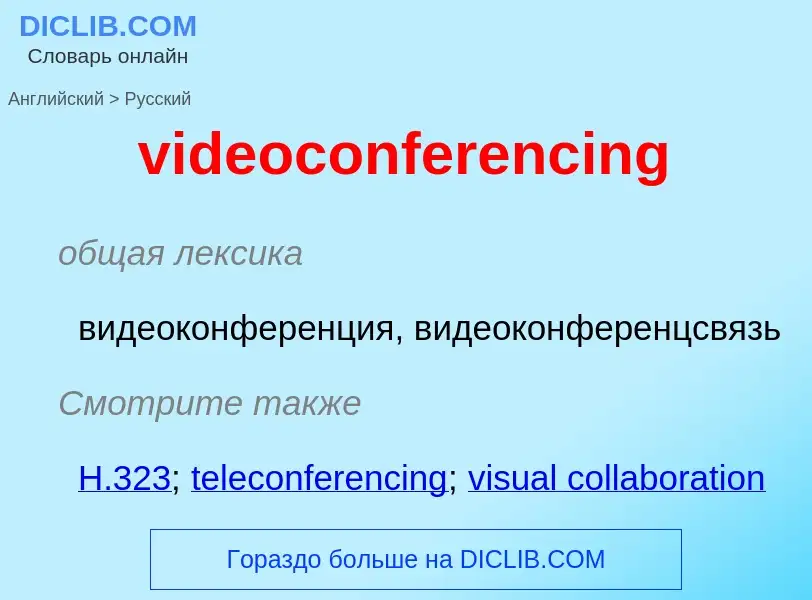Tradução e análise de palavras por inteligência artificial ChatGPT
Nesta página você pode obter uma análise detalhada de uma palavra ou frase, produzida usando a melhor tecnologia de inteligência artificial até o momento:
- como a palavra é usada
- frequência de uso
- é usado com mais frequência na fala oral ou escrita
- opções de tradução de palavras
- exemplos de uso (várias frases com tradução)
- etimologia
videoconferencing - tradução para russo
общая лексика
видеоконференция, видеоконференцсвязь
Смотрите также
существительное
общая лексика
видеоконференция
Wikipédia
Videotelephony, also known as videoconferencing and video teleconferencing, is the two-way or multipoint reception and transmission of audio and video signals by people in different locations for real time communication. A videophone is a telephone with a video camera and video display, capable of simultaneous video and audio communication. Videoconferencing implies the use of this technology for a group or organizational meeting rather than for individuals, in a videoconference. Telepresence may refer either to a high-quality videotelephony system (where the goal is to create the illusion that remote participants are in the same room) or to meetup technology, which can go beyond video into robotics (such as moving around the room or physically manipulating objects). Videoconferencing has also been called "visual collaboration" and is a type of groupware.
While development of video-conferring started in the late 19th century, the technology only became available to the public starting in the 1930s. These early demonstrations were installed at "booths" in post offices and shown at various world expositions. It took until 1970 for AT&T to launch the first true video-conferring system, where anyone could subscribe to the service and have the technology in their home or office. Video telephony also included "image phones" which would exchange still images between units every few seconds over conventional plain old telephone service (POTS) lines, essentially the same as slow-scan TV. The development of advanced video codecs, more powerful CPUs, and high-bandwidth Internet service in the late 1990s allowed videophones to provide high-quality low-cost color service between users almost any place in the world where the Internet is available.
Useful applications include sign language transmission for deaf and speech-impaired people, distance education, telemedicine, and overcoming mobility issues. It is also used in commercial and corporate settings to facilitate meetings and conferences. News media organizations have begun to use desktop technologies like Skype to provide higher-quality audio than the cellular phone network, and video links at much lower cost than sending professional equipment or using a professional studio. More popular videotelephony technologies use the Internet rather than the traditional landline phone network, even though modern phone networks use digital packet protocols, and videotelephony software commonly runs on smartphones over digital radiotelephony networks.



![Global Schoolhouse students communicating via [[CU-SeeMe]], shown here with a video [[frame rate]] between 0.9 and 3 frames per second (1993) Global Schoolhouse students communicating via [[CU-SeeMe]], shown here with a video [[frame rate]] between 0.9 and 3 frames per second (1993)](https://commons.wikimedia.org/wiki/Special:FilePath/CUcollaboration.gif?width=200)

![A videoconference meeting facilitated by [[Google Hangouts]] A videoconference meeting facilitated by [[Google Hangouts]]](https://commons.wikimedia.org/wiki/Special:FilePath/GoogleHangoutsMeeting.jpg?width=200)
![The [[Kyocera]] VP-210 Visual Phone was the first commercial mobile videophone (1999). The [[Kyocera]] VP-210 Visual Phone was the first commercial mobile videophone (1999).](https://commons.wikimedia.org/wiki/Special:FilePath/Kyocera VP-210 CP+ 2011.jpg?width=200)
![NLS computer technology]] (1968) NLS computer technology]] (1968)](https://commons.wikimedia.org/wiki/Special:FilePath/On Line System Videoconferencing FJCC 1968.jpg?width=200)
![''2001: A Space Odyssey'']] calls his daughter on Earth ''2001: A Space Odyssey'']] calls his daughter on Earth](https://commons.wikimedia.org/wiki/Special:FilePath/On Space Station V, Dr. Heywood Floyd places a videocall to his daughter on Earth.jpg?width=200)
![SIP]]-only device. Such devices need to route calls through a Video Communication Server to be able to reach [[H.323]] systems, a process known as "interworking" (2009). SIP]]-only device. Such devices need to route calls through a Video Communication Server to be able to reach [[H.323]] systems, a process known as "interworking" (2009).](https://commons.wikimedia.org/wiki/Special:FilePath/TANDBERG E20.jpg?width=200)


![Sony Ericsson]] [[K800]] (2007) Sony Ericsson]] [[K800]] (2007)](https://commons.wikimedia.org/wiki/Special:FilePath/Video Call.jpg?width=200)
